Recently we applied for some provincial funding to improve our operation. First we applied for a cost share program to purchase a RFID tag reader. An RFID tag is a little yellow button tag that all cattle ranchers have to put in their cattle before they can leave a ranch in Canada. It is the major component to our food safety system. When you buy RFID tags all those tags in that box are assigned to your ranch and the specific tag you put in animal gets registered with CCIA (Canadian Cattle Identification Agency) and that tags follow the animal throughout all the steps in the processing chain, so if there was every a food safety problem it can be tracked back to its herd of orgin.
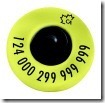 RFID tag
RFID tag
We are really excited about having this reader because it will streamline our operation. Before I had a book at would write down calving information(when a cow calved, description of the calf, sex of the calf, and if there were any calving problems and other information about the animals like if they were sick, what we doctored them with and the withdrawal period. I would also have their RFID number beside their dangle tag number.
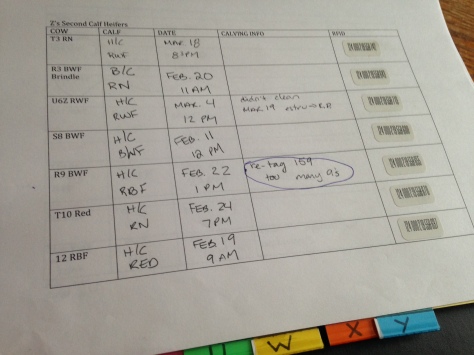
On the left is the cows dangle tag number, the number we assign them like their name, the next column is information about their calf sex and colour description. the next column is their calving date, the next column is any information about them. If you look at cow U6Z I have written beside her that she didn’t clean and we treated her. Then on a separate page I write what we treated the specific animal with, the withdrawal date along with the animal’s identification.
The column furtherest to the right is where I put a sticker of that calf’s RFID tag number. So before we got this new technology it was all manual.
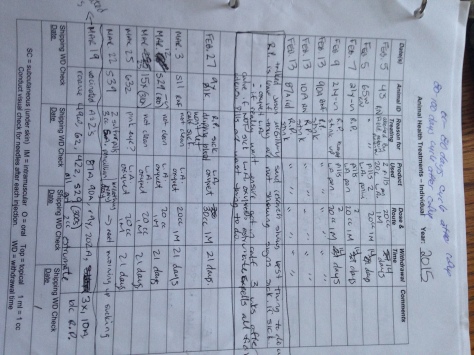
Here is the other sheet where I write down the specific animal that was treated, what they were treated with and the withdrawal date.
Now, with our fancy new technology I can enter all that on a data collector an link the animals RFID tag number to their dangle tag number and have all their information pop up. This really helps because in the mountains the cows lose their dangle tags quite frequently and when they come home we are not sure which cows that is anymore, now with the RFID reader we can scan their RFID tag and it will bring up all the information on them. Their dangle tag is like their name to us, all my friends and family know me by Erika, we know our cows by their tag number for example R9B.
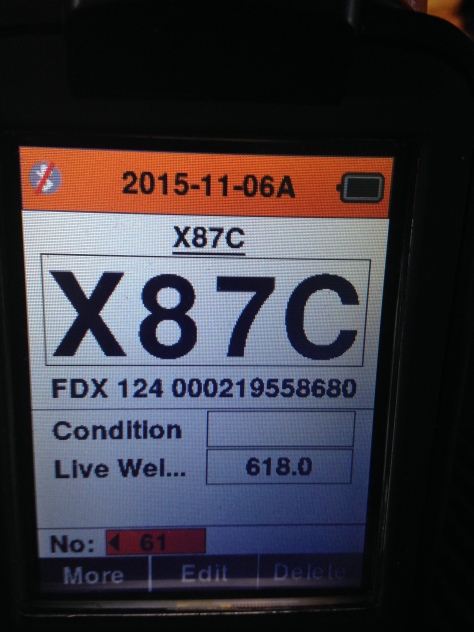
Here is a picture of the screen of the RFID reader. It scans the RFID tag that is the 15 digit number that comes up and then I can enter their dangle tag number, the number we assign them and know them as this one was X 87C With our scales we are also able to enter their weight as well.
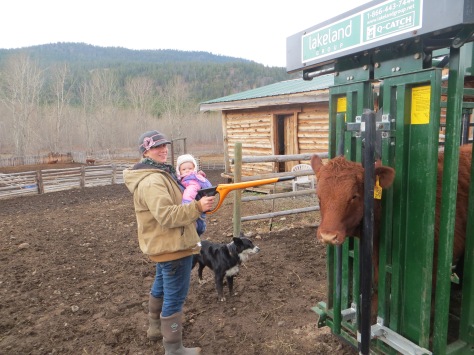
The RFID reader in action.
I think this new system is very important piece of the Canadian Food Safety system puzzle. This way we can be sure exactly which animal is which and of the vaccinations, medication we have given them along with the withdrawal periods.
What is a withdrawal period you ask???
If an animal is sick and we treat them with medication there is a certain amount of time before the animal can be slaughtered for human consumption that is the withdrawal period. For example, during calving season if we get a cows with a retained placenta (she hasn’t expelled her placenta after she has given birth to her calf). If she doesn’t expell the placenta properly it can start to rot inside her and she can get very sick and sometimes die or not be able to rebreed, so it is very important we treat her. If we give this cow Oxyvet the withdrawal period is 21 days, so we cannot sell that animal for 21 until that medication is out of her system and then safe for human consumption.
We also applied and were successful in our application for cost share funding for weigh scales and a data collector for our squeeze chute. We use a squeeze chute when pregnany checking, which I talked about in my last blog, when we are vaccinating, and if we have to treat a sick animal. Cows and bulls are huge animals our average cow would weight 1200+ pounds so if we need to restrain them to treat them we do this in a squeeze chute, which safely contains the animal and allows us to get very close and treat them.
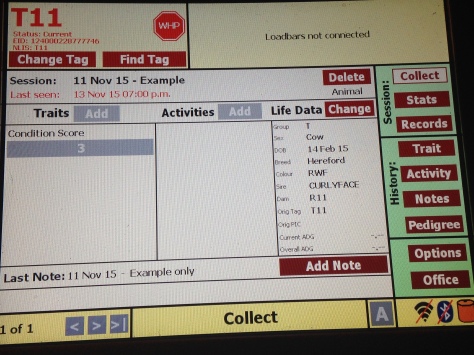
The data collector for the scale. This and the RFID tag reader “talk” and when we can an RFID tag the information will come up here. In the top left corner it says T11 that is the cows dangle tag number below EID (electronic identification or RFID tag number. We can also input a ton of different information, treatments and withdrawal dates, weight, breed.
The weigh scales are important because when treating a sick animal the proper dosage administered is according to the animals weight. Now we are able to get a precise weight from the animal and can administer the accurate amount of medication. Scales are also great to have we can collect a lot more information about our herd with them like how much weight they are putting on per day we call the ADG (average daily gain).
We are just so excited about our new tools and so thankful there are cost share programs available to help us streamline our operation and continue to improve our Canadian Food Safety systems because without the cost sharing programs we could not afford these tools.






great job you gals are doing…I am pretty familiar with your industry but enjoy how you break the year down and really take the time as to what and why you are doing! Keep up the good work!
Thank you so much!
Erika, very interesting article regards to RFID,, can you download information to your home computer for future reference. Thank your for the work being done.
Jerry